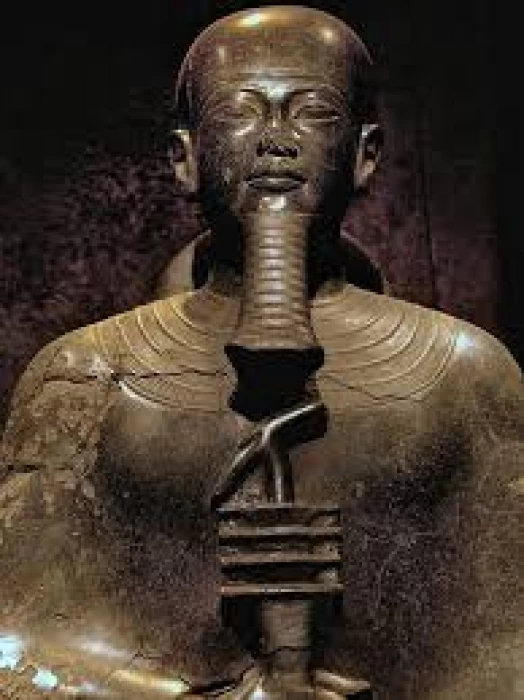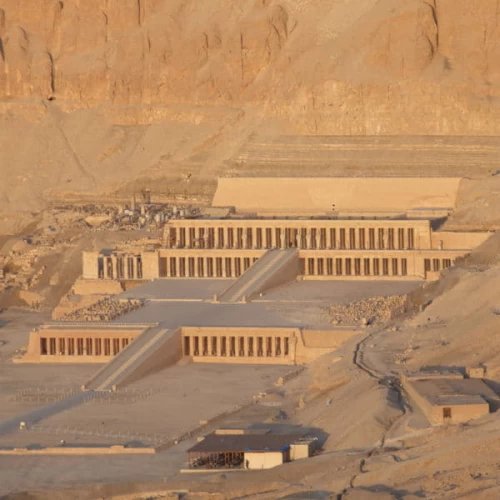
Deus Ptah | o Deus da Criação e dos Artífices
Deus Ptah
Ptah era o sumo sacerdote do seu templo em Memphis também o deus do ofício. Foi um dos da Tríade de Memphis com a sua esposa Sekhmet (uma das deidades mais antigas e poderosas. representada como leoa, a filha do deus sol Amun Ra, e é conhecida como a deusa do sol e da guerra)e Nefertum (representa o nascer do sol, e diz-se que ele criou a humanidade a partir das suas lágrimas).
o Deus da Criação e dos Artífices
Ptah também realizou um importante ritual chamado (Abertura da Boca), um ritual funerário para garantir que a pessoa falecida fosse capaz de comer e beber no além.
No Velho Reino, ele já estava identificado com Sokar, o deus da necrópole de Memphis: Ptah e Sokar unificaram assim a cidade dos vivos com a cidade dos mortos. Uma outra identificação, que se move de Osíris como o deus dos mortos, leva à formação de Ptah-Sokar-Osiris, como uma divindade transcendente em Memphis e, por esta altura. A partir do Novo Reino ele recupera a sua individualidade, é o marido da deusa Sekhmet e o pai do deus Nefertum.
Viaja ao Egipto para visitar os templos e pirâmides egípcios para aprender mais sobre a mitologia e centenas de deuses adorados pelos Faraós que eram muito parecidos com os humanos que amavam e odiavam, sentiram ciúmes e lutaram e morreram durante um mito surpreendente cheio de alegria, acção e acontecimentos dramáticos que inspiraram os realizadores e produtores de cinema modernos a criar filmes mundialmente famosos sobre a grandeza dos Faraós e dos deuses que adoravam. Passe alguns dias para visitar Abydos, Giza, Luxor, Assuão para ver os túmulos dos Faraós adornados com cenas muito claras, detalhadas e belamente pintadas das várias divindades do antigo Egipto, bem como muitos outros locais, cidades, aventuras, e coisas para fazer no Cairo, pode tentar reservar um dos nossos pacotes de viagens ao Egito e muitos grupos privados de excursões guiadas de um dia no Cairo a partir do aeroporto e de um dia no Egipto para explorar a capital do Egipto, Cairo pode verificar muitos dos itinerários do Egipto ou fazer uma das nossas excursões completas do Dia do Cairo, como por exemplo:
Ptah was the high priest of his temple at Memphis and also the god of Crafts. He was one of the Triad of Memphis with his wife Sekhmet (one of the oldest and most powerful deities. represented as a lioness, the daughter of the sun god Amun Ra, and is known as the goddess of sun and war)and Nefertum (he represents the sunrise, and it is said that he created mankind from his tears).
Ptah also held an important ritual called (Opening of the Mouth), a funerary ritual to ensure that the deceased person would be able to eat and drink in the afterlife.
In the Old Kingdom, he was already identified with Sokar, the god of the necropolis of Memphis: Ptah and Sokar thus unified the city of the living with the city of the dead. A further identification, which moves from Osiris as the god of the dead, leads to the formation of Ptah-Sokar-Osiris, as a transcendent divinity in Memphis and, by now. Starting from the New Kingdom he regains his individuality, he is the husband of the goddess Sekhmet and the father of the god Nefertum.
Path
- Lord of Ankh Tawy 'The Life of the Two Lands' refers to the unification of Upper and Lower Egypt.
- Nefer Her "Ptah with a beautiful face" refers to the belief that his flesh was made of gold.
- Ptah-Sokar-Osiris : At the end of the period (737–332 BC), the combined traits of the gods gained popularity, and this composite deity assisted the deceased in his trip to the afterlife. A carved wooden statue of the composite god was among the funeral items placed inside the tomb containing the deceased.
- Ptah-Sokar-Atoum's affiliation with the deity of the dead, Sokar, and the creator god of Heliopolis, Atoum, shares many characteristics with Osiris.
Ptah is depicted as a man with green skin, sheathed in a very tight-fitting shroud and capped with a simple blue cap; he holds vertically in both hands a composite scepter bringing together: the sceptre Ouas, the cross ânkh and the pillar Djed, the emblems of life, stability and omnipotence. Unlike the other gods, he wears the straight beard of the pharaohs. Around the neck it has a wide collar held in place by a counterweight on the back. Sometimes, it rests on a pedestal (base of the throne) which has the shape of a hieroglyph and whose meaning is also a symbol for Maât ("world order").
Present the architectural wonders dedicated to Ptah:
The great temple of Ptah in Memphis: A complex that radiated power and divinity, becoming the beating heart of the worship of Ptah.
Other curiosities: The minor temples and altars scattered across Egypt reveal the extent of his adoration.
Beautiful decorations and artwork that honoured Ptah's strength and inventiveness were found inside the temples.















